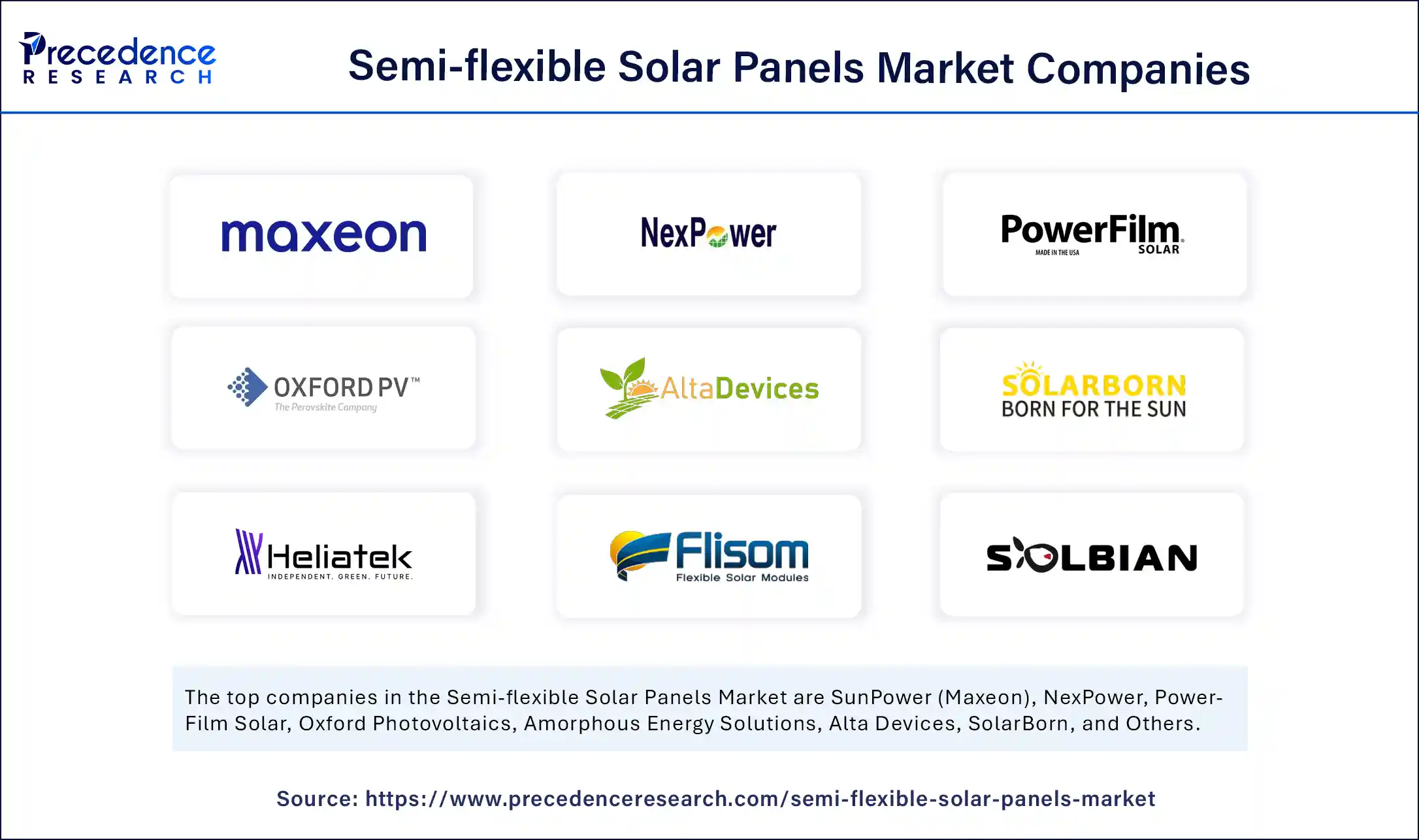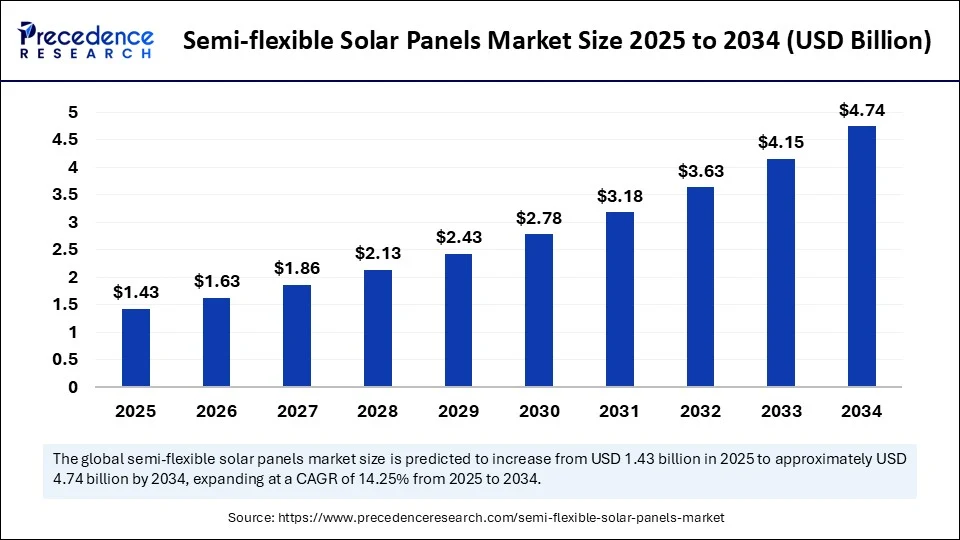The global semi-flexible solar panels market is undergoing a remarkable transformation, expanding from USD 1.43 billion in 2025 to a projected USD 4.74 billion by 2034—translating to a robust CAGR of 14.25%. Spurred by the escalating demand for lightweight, portable, and adaptable solar solutions, this market is gaining traction across residential, commercial, and off-grid sectors.
The semi-flexible solar panels sector is witnessing explosive growth as consumers and businesses alike search for durable, easy-to-install, and flexible solar technologies. Asia Pacific, in particular, stands at the forefront, with government incentives and rapid manufacturing innovations driving market leadership. Meanwhile, artificial intelligence (AI) is playing a pivotal role in optimizing production lines, enhancing quality control, and accelerating product innovation—making these panels ever more attractive for modern energy requirements.
Semi-Flexible Solar Panels Market Quick Insights
-
The market is forecast to surge from USD 1.43 billion in 2025 to USD 4.74 billion by 2034, registering a CAGR of 14.25%.
-
Asia Pacific dominates the scene, with its semi-flexible solar panels market expected to reach USD 1,445.7 million by 2034.
-
The Middle East & Africa region is experiencing the fastest growth due to increased off-grid solar adoption.
-
The thin film (CIGS) substrate is the leading technology in 2024, prized for flexibility and high energy conversion.
-
Commercial applications and portable/consumer segments are commanding substantial market shares.
-
Leading players and innovators are advancing both perovskite and flexible crystalline silicon technologies.
Get this report to explore global market size, share, CAGR, and trends, featuring detailed segmental analysis and an insightful competitive landscape overview @ https://www.precedenceresearch.com/sample/6608
Semi-Flexible Solar Panels Market Revenue Table
| Metric | Value |
|---|---|
| Market Size (2024) | USD 1.25 Billion |
| Market Size (2025) | USD 1.43 Billion |
| Market Size (2034, Forecast) | USD 4.74 Billion |
| CAGR (2025–2034) | 14.25% |
| Dominant Region (2025) | Asia Pacific |
| Fastest Growing Region (2025–2034) | Middle East & Africa |
| Top Segment by Technology | Thin Film (CIGS) |
| Top Segment by Application | Portable/Consumer |
| Largest Power Output Segment (2024) | 50W–200W |
| Leading Mounting Type | Frame-Mounted Kits |
| Top End-User Sector | Commercial |
Artificial intelligence is transforming how semi-flexible solar panels are designed, manufactured, and maintained. By automating production steps and leveraging machine learning to predict panel durability and optimize material selection, AI reduces manufacturing defects and shortens lead times. This not only lowers costs but also boosts panel reliability—making them better suited to a variety of demanding environments.
AI’s impact extends beyond the factory floor. Predictive analytics are increasingly being used for monitoring temperature, sunlight exposure, and wear rates, allowing for real-time performance optimization and better preventive maintenance. As a result, semi-flexible panels have become a dependable and cost-effective solution for curved, mobile, or off-grid installations—from electric vehicles and boats to building-integrated solar systems.
What’s Fueling the Semi-Flexible Solar Panels Market Growth?
-
Rising Adoption of Renewables: Widespread investment in sustainable energy infrastructure and stricter emission regulations are creating fertile ground for flexible solar solutions. Consumers and businesses are keen on portable, adaptable products that can power everything from outdoor gear to corporate offices.
-
Incentivizing Policy Support: Tax benefits, subsidies, and green building codes are making semi-flexible panels more accessible, with educational programs highlighting their unique advantages in various sectors.
-
Breakthroughs in Technology: Continuous innovations, especially in flexible perovskite/silicon tandem cells, are driving panel efficiencies toward the coveted 30% mark, opening up new possibilities for lightweight, high-output applications.
-
Flexible Integration: Growth in electric vehicle adoption, along with a surge in demand for power in marine, RV, and recreational sectors, is expanding the use-cases for semi-flexible solutions.
Are There Untapped Opportunities and Noteworthy Trends?
-
How Will Electric Vehicle Integration Shape the Market?
As the shift to electric vehicles accelerates, semi-flexible solar panels mounted on car roofs promise auxiliary charging and efficiency gains—even for minor vehicle systems. This integration can reduce grid reliance and extend vehicle range, especially important for off-grid use and emergencies. -
Will Next-Gen Flexible Solar Technologies Disrupt the Norm?
Breakthroughs in tandem and perovskite cell technology are making lightweight high-wattage solar solutions viable. This trend is unlocking whole new markets—such as remote commercial sites and heavy-duty off-grid deployments—that traditional solar could not reach.
Semi-Flexible Solar Panels Market Regional Analysis
-
Asia Pacific: Commands the largest share, thanks to urban expansion, favorable government policies, and technological dominance. Mass manufacturing and declining costs ensure strong regional leadership.
-
Middle East & Africa: Witnessing rapid growth, supported by off-grid adoption, sun-rich geography, and large public/private investments in renewable infrastructure.
-
North America, Europe, Latin America: Also see notable market activity, with a focus on building-integrated photovoltaic (BIPV) systems and outdoor recreation.
Segmentation Overview
-
Technology/Substrate: Dominated by thin film (CIGS) for its flexibility and install versatility; ultra-thin crystalline silicon is gaining rapid ground due to efficiency advancements.
-
Application: The portable/consumer segment leads, benefiting from demand in personal electronics, camping, and gadgets, while marine and RV uses are booming due to travel trends.
-
Power Output Range: 50W–200W panels are preferred for small appliances and portability, while demand is surging for higher-wattage panels in industrial deployments.
-
Mounting Type: Frame-mounted kits offer the best weather resistance and longevity; adhesive-backed formats are quickly rising for their DIY-friendly installation on curved surfaces.
-
End-User Sector: Commercial users dominate for now, but institutional and government use is ramping up—spurred by defense, disaster relief, and remote infrastructure projects.
Semi-flexible Solar Panels Market Companies

- SunPower (Maxeon)
- NexPower
- PowerFilm Solar
- Oxford Photovoltaics
- Amorphous Energy Solutions
- Alta Devices
- SolarBorn
- Heliatek
- Flisom
- Solbian (Solbian R&D)
- Innovation Solar
- AltaGlass
- Flexcell Solar
- Voltaic Systems
- SolarFlexPower (Zhejiang)
- Pophypower (FlexCell)
- Rollbond
- LIM Group
- Sunflare
- Tigo Energy (FlexModule)
Latest Breakthroughs & Company Innovations
-
Advancements in tandem and perovskite technologies are pushing flexible panel efficiencies to new heights.
-
Leading manufacturers are scaling up mass production while implementing AI-driven quality control systems to minimize defects and optimize durability.
Which Challenges and Cost Pressures Loom Largest?
Despite their many benefits, semi-flexible solar panels typically come at a higher price per watt compared to rigid crystalline silicon modules due to the specialized materials and manufacturing processes required. Limited consumer awareness outside niche markets and hesitancy over up-front costs—especially in emerging economies—continue to pose adoption obstacles. Mainstream visibility and education remain crucial for broader market capture.
Case Study: Powering Remote Projects with Semi-Flexible Panels
A leading mobile telecom provider in Africa recently equipped its remote cellular towers with semi-flexible solar arrays, slashing diesel generator dependence and ensuring stable connectivity for thousands. The panels’ light weight and easy installation made them ideal for difficult, off-grid settings subject to frequent relocation and harsh weather.
Read Also: Glass Interposers Market
You can place an order or ask any questions, please feel free to contact at sales@precedenceresearch.com |+1 804 441 9344
